The following article looks at teaching foundation phase players off the ball movement. U8 players learn to move in activities where they see most of the ball, U10 players learn movement through small group activities and U12 players learn to move to create space for themselves and team mates
"In most scenarios, it isn't the person on the ball who decides where the ball goes, but players without the ball. Their running actions determine the next pass." - Johan Cryuff
We've all had it when players stand still waiting for a pass to come, as opposed to making a clever run or stepping into the most appropriate space to receive. Teaching players how to move off the ball is a skill that coaches must encouarge from U8, albeit in a different manner to how it would be done at U12. As the quote above suggests, if we have coached our players how to be aware then the movement of players off the ball will determine where the ball goes next.
Movement at U8
Technical - U8 players should learn the difference between light and heavy touches when in 1 v 1 situations, as well as when to use them.
Tactical - Players are to learn how to combine with a team mate to beat an opponent, using the 1-2 and overlap to create an advantage.
Physical - Players need to learn how to control their speed, understanding when to go flat out and when to slow down. This refers to both on and off the ball.
Social - My friend and I. U8's often have 1 best friend in their social situations. In soccer this also true, meaning 2v1/2v2 activities should form the basis of group activities. They are more likely to pass if they feel they will get the ball back. Less players on the field also means more space in which to run.
Game - Dribble or Combine

Set up a 20x10 field. 3 players wear yellow bibs and 3 players wear blue bibs. 2 yellows and 2 blues are placed on the outside of the playing area. The remaining 2 players are positioned 1 v 1 inside the playing area. The coach stands at the side of the playing area with balls. The coach passes a ball to the yellow player. The yellow plays 1 v 1 against the blue to goal. The player in possession can pass to an outside player to retain the ball. After the ball is scored/out of play, the coach passes the next ball into the blue. Repeat 4 times, then switch the inside players.
Progression
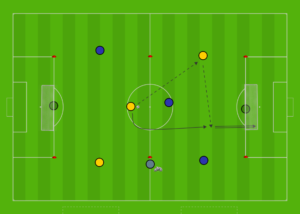
The outside player who is first passed to is allowed to enter the field upon returning the pass, creating a 2 v 1 in-field.
Movement Coaching Points
Pass one way, run the other
Use visual communications - point where you want the ball
Don't wait for the pass
Forward run if space is in front, overlap if space is behind. Use the halves of the field as a reference point
Player on the ball to observe the defenders reaction to the runner and make decision accordingly
Why it Works
The inside players get plenty of touches of the ball. Players must decide when to keep the ball close and when to have a heavier touch to beat the opponent. Using the outside players allows them opportunities to make quick runs off the ball to get goal side of their opponent. Players are happy to pass knowing that they will be getting the ball back.
Movement at U10

Technical - U10's main technical focus is receiving the ball, both to their feet and to the space in front of them.
Tactical - Players must aim to provide appropriate support to the player on the ball. This comes from options to the left, right and in front.
Physical - Players are to incorporate dynamic movements into their warm up. This is to aid their movements in a game.
Social - Small groups start forming at U10. Practices with 3/4 players providing an overload are to take precedence.
Game - Combination Pairs
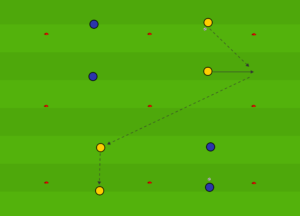
Set up a 20x20 playing area, split into four 10x10 squares. Players are split into 2 groups of 4. Both groups have 2 players inside the playing area, and a target player at either end. Both teams start with a ball at the feet of a target player. The central players receive the ball, combine and pass through to the target player on the opposite side. Both pairs move in opposite directions. Repeat for 90 seconds and switch places.
Progression
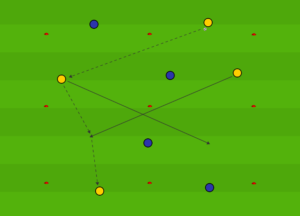
1 ball. 1 pair defends, the other tries to play across. Defending players can only defend one half of the playing area each.
Movement Coaching Points
Open body shape to see the playing area
Switch sides to drag defenders out of position
Run into space at speed
Pass where the runner is moving to, not where they are standing
Use visual communication to show where you want the ball
Why it Works
The back and forth nature of the practice means players get plenty of repetition to work the technique of receiving the pass. The player on the ball always has 3 supporting options with the 4 v 2 overlaod when in possession. Quick sprints, back and side steps are all needed in this activity.
Movement at U12
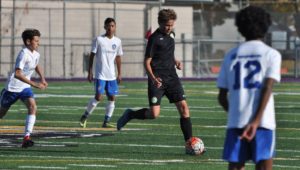
Technical - Accuracy and particularly weight of pass is vital to the development of U12 players.
Tactical - Players should be looking to create space for both themselves and others to exloit.
Physical - Players should start to become comfortable using their heads and chests to control the ball, due to the increase in growth they are experiencing.
Social - Large group work. Units (e.g. Def & Mid) working together to achieve success.
Game - Sequence Passing Squares
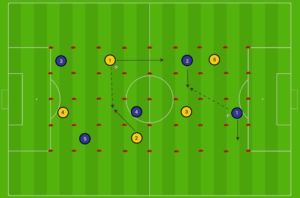
Set up a grid of multiple 6x6 squares. Split players into 2 teams, with each player numbered. Number 1 on each team starts with a ball. Players start in a square on their own. Players pass the ball in number order. The receiving player must receive the pass while moving into a new square. The passing player must find a new square after they pass. Race groups against each other and take points off for standing still.
Progression
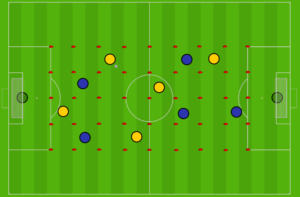
Add a goal at either end and play a small sided game. Players are to use sqaures as a visual aid for their movement.
Movement Coaching Points
Players to scan the field to see the square to move into
Open body to see as much space as possible
Double movement when receiving
Move after pass and when looking to receive
Units must work together to cover gaps and penetrate the opposition
Why it Works
The size of the sqaures requires accurate and correctly weighted passes to achieve success. By leaving a square after passing/before receiving, layers open up space for a team mate to occupy. A long pass for a forward run or switch of play encourages aerial control. Units must work together to occupy the appropriate spaces for attacking penetration and defensive security.

